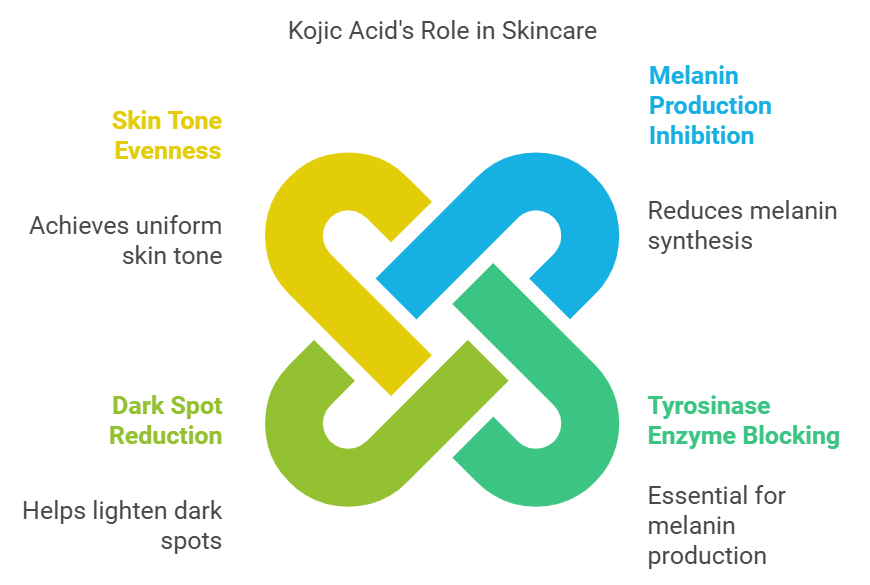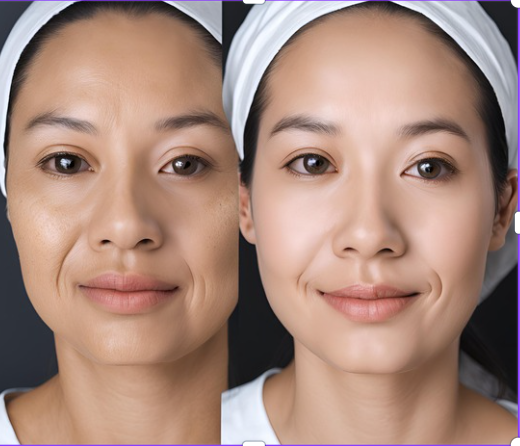- Kojic acid works by inhibiting tyrosinase, reducing melanin production and lightening the skin.
- Research shows that kojic acid is effective in treating hyperpigmentation when used consistently.
- Potential side effects include irritation, contact dermatitis, and increased sun sensitivity.
- Use products with 1% or less kojic acid to minimize risks and ensure safety.
- Kojic acid is a safer option compared to hydroquinone for skin lightening.
In the world of skincare, kojic acid has become a hot topic. Known for its ability to lighten skin and tackle hyperpigmentation, it’s often found in creams, serums, and soaps. But how does it work? What’s the science behind this popular ingredient? And most importantly, is it safe? Let’s break down everything you need to know about kojic acid, including research-backed benefits and potential side effects.

How Kojic Acid Lightens Skin
The key to kojic acid’s effectiveness lies in inhibiting tyrosinase, an enzyme responsible for melanin production. Melanin is the pigment that gives your skin its color. When tyrosinase activity is reduced, melanin production decreases, leading to lighter skin over time.
Tyrosinase Inhibition Explained
Tyrosinase is crucial for the synthesis of melanin. Kojic acid works by blocking the activity of this enzyme, which slows down the production of melanin. As a result, skin discoloration, age spots, and other forms of hyperpigmentation start to fade.
Skin Lightening: How Long Does Kojic Acid Take to Work?
What the Research Says
Numerous studies have explored how kojic acid works and its safety for long-term use. Here are studies that provide valuable insights into kojic acid’s role in skin lightening.
A safer alternative to hydroquinone
A 2020 study compared the effects of kojic acid and hydroquinone on skin. Hydroquinone is a controversial, skin-lightening agent that has been linked to side effects like skin irritation and ochronosis (a bluish-black discoloration). The study found that while hydroquinone caused structural damage to the skin of rats, kojic acid did not.
Conclusion: Kojic acid is a safer alternative to hydroquinone in skin-lightening formulations, as it does not disrupt skin structure.
Inhibit tyrosinase and reduce melanin production
A 2022 review by Phasha V et al. explored kojic acid’s ability to inhibit tyrosinase and reduce melanin production. It highlighted that kojic acid is effective but should be used in concentrations below 1% to avoid cytotoxicity, or cell damage.
Conclusion: Kojic acid is effective for treating hyperpigmentation, but lower concentrations (under 1%) are recommended for safety.
Kojic acid stability and safety
This 2022 review emphasized kojic acid’s anti-tyrosinase activity. It discussed stability issues with kojic acid and potential cytotoxicity at higher concentrations. But it also mentioned that newer kojic acid derivatives are more stable and offer similar skin-brightening benefits.
Conclusion: Kojic acid is popular for skin brightening, though stability and safety should be considered when selecting products.
How to Achieve a Brighter Complexion with Kojic Acid
reliable skin-lightening agent
A 2022 review consolidated data on kojic acid’s biological activities, including its antioxidant properties. This review also reaffirmed kojic acid’s ability to inhibit melanin production through tyrosinase binding.
Conclusion: Kojic acid is a reliable skin-lightening agent with a favorable safety profile at recommended concentrations.
Kojic acid has minimal side effects
An older review, published in NCBI in 2013, compared kojic acid to other skin-lightening agents, such as hydroquinone. Kojic acid was found to be a competitive inhibitor of tyrosinase, effectively reducing melanin synthesis without the severe side effects linked to hydroquinone.
Conclusion: Kojic acid is an effective treatment for hyperpigmentation, providing a safer alternative to agents like hydroquinone.
Real-Life Results: How Long Does It Take?
If you’re wondering how long kojic acid takes to work, the answer varies. While some people start seeing results in a few weeks, for others, it can take several months of consistent use to notice significant changes.
Here are some real-life experiences from users:
-
Chemists Corner: One user using a 3% kojic acid formula saw a noticeable change in their skin color within two months.
-
Acne.org Forum: A user saw improvements in skin clarity after three weeks of using kojic acid soap but later experienced breakouts, likely due to harsh ingredients in the soap.
-
Reddit – Brown Beauty Community: Another user who used Kojie-san soap for years reported gradual improvements in skin tone, emphasizing the importance of consistency.
-
Indian Skincare Addicts: A participant noticed fading acne scars within a month of using kojic acid cream recommended by their dermatologist.
The common thread in these stories? Patience and consistency are key. Kojic acid isn’t an overnight solution, it takes time to see results.
What Are the Side Effects of Kojic Acid?
While kojic acid is generally safe when used in appropriate concentrations, it can still cause side effects in some people. Here are a few potential risks:
-
Irritation: Some users may experience redness, itching, or a burning sensation, especially if they have sensitive skin.
-
Contact Dermatitis: Prolonged use of high concentrations of kojic acid may lead to contact dermatitis, an inflammatory skin condition.
-
Sun Sensitivity: Kojic acid makes your skin more sensitive to UV rays, increasing the risk of sunburn and further hyperpigmentation.
To minimize these risks, dermatologists recommend starting with low concentrations (below 1%) and always using sunscreen when applying kojic acid during the day.
Stability and Derivatives: Making Kojic Acid More Effective
One of the challenges with kojic acid is its instability. Kojic acid can degrade when exposed to air and light, which can reduce its effectiveness in skincare products. To combat this, researchers have developed kojic acid derivatives, like kojic acid dipalmitate, which offer more stability and similar skin-lightening benefits.
If you’re concerned about the stability of kojic acid in your products, look for formulations that include these derivatives, as they may provide better long-term results.
Final Thoughts: Is Kojic Acid Right for You?
Kojic acid is a great option for those looking to lighten dark spots, sun damage, or hyperpigmentation. It works by inhibiting the production of melanin, and while it’s not a quick fix, consistent use can bring about noticeable changes. As always, using sunscreen alongside kojic acid is essential to protect your skin from further damage.
Whether you’re new to skincare or looking to switch up your routine, kojic acid offers a safer, effective alternative for those looking to brighten their skin tone naturally.

I’m a devoted organic skincare enthusiast, passionate about the natural, wholesome goodness that organic products bring to our skin.
Organic skincare isn’t just a hobby for me—it’s a lifestyle. Every product I use, recommend, and write about has been carefully chosen for its purity and effectiveness. Everything I write about is backed by scientific studies, dermatologists’ opinions, and user experiences.
I also excel at tackling skincare challenges with innovative, organic solutions.

